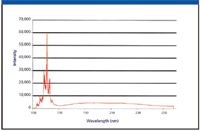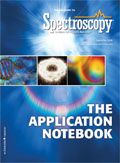Economical Maya2000 Pro Extends to VUV
Spectral measurements down to 153 nm can be achieved easily and economically with the high-sensitivity Maya2000 Pro with Extra-Deep-UV Option. Nitrogen purging of the spectrometer helps to mitigate water and oxygen absorption in the vacuum ultraviolet.
Spectral measurements down to 153 nm can be achieved easily and economically with the high-sensitivity Maya2000 Pro with Extra-Deep-UV Option. Nitrogen purging of the spectrometer helps to mitigate water and oxygen absorption in the vacuum ultraviolet.
A variety of materials have spectral signatures in the vacuum ultraviolet (VUV) spectral region, typically described as the region from 10 nm–200 nm (1,2), where air and water begin to absorb and require the use of a vacuum. VUV spectroscopy is useful for applications ranging from biomedicine to semiconductor testing. Because the spectral response of standard silicon charge-coupled device (CCD) detectors drops off rapidly at wavelengths as long as 400 nm, and because oxygen and water absorb in the VUV spectral band, maintaining sufficient signal outside a vacuum is not possible. Designing vacuum-compatible spectrometers to address these issues can be difficult and expensive. As a result, most commercially available VUV spectrometers require custom configuration and are too expensive and unwieldy for many common applications.
The Maya2000 Pro with Extra-Deep UV Option is poised to change that. The spectrometer features a 101.6-mm focal length optical bench with a compact crossed Czerny–Turner design and a back-thinned CCD detector that offers superior UV and VUV performance. To minimize signal attenuation inside the optical path, the spectrometer bench is purged with nitrogen, achieving a robust signal for VUV experiments at wavelengths as low as 153 nm (testing performed at NIST independently validated similar results at VUV wavelengths).
Experimental Conditions
To test performance, we started with a Maya2000 Pro configured with a high resolution, UV-enhanced 2400 g/mm holographic diffraction grating and a 5-μm slit. The back-thinned detector (Hamamatsu S10420-1106) features a peak quantum efficiency of 75%, with UV quantum efficiencies as high as 50%. A custom magnesium fluoride (MgF2) glass window is placed over the detector for improved transmission over VUV wavelengths.
The test sample for the experiment was a VUV deuterium lamp with a VUV-grade optical window, coupled directly to the spectrometer. We enclosed the source and spectrometer and purged the region with standard laboratory-grade nitrogen.
Results
Integration time for the measurement was 50 ms. The resultant emission spectrum shows sharply defined spectral peaks at wavelengths as low as 153 nm, with a strong central peak around 161 nm (Figure 1). The system operated with a spectral resolution of 0.1 nm and a signal-to-noise ratio of 450:1.

Figure 1: Emission spectrum of a VUV deuterium lamp shows clearly defined peaks, with good signal-to-noise performance and 0.1 nm (FWHM) optical resolution.
We have also used the system to measure a solution containing carbon, hydrogen/deuterium, nitrogen, oxygen, sulfur, chlorine, bromine, silicon and fluorine chromatographically separated into a column and placed in a vacuum chamber with a helium plasma mixture. VUV spectral features were clearly apparent in the spectrum, suggesting a wide variety of short-wavelength applications is achievable.
Conclusions
The results demonstrate that the reliable and economical Maya2000 Pro can be easily extended to VUV applications. Current work is focusing on studying different types of samples and pushing the spectral range to lower wavelengths.
References
(1) Wikipedia, http://en.wikipedia.org/wiki/Ultraviolet Website covers VUV under larger section on ultraviolet light.
(2) H. Horspool, F. Lenci, CRC Handbook of Organic Photochemistry and Photobiology (CRC Press, 2003).

Ocean Optics Inc.
830 Douglas Ave.
Dunedin, FL 34698
Tel. +1-727-733-2447, Fax +1-727-733-3962

Thermo Fisher Scientists Highlight the Latest Advances in Process Monitoring with Raman Spectroscopy
April 1st 2025In this exclusive Spectroscopy interview, John Richmond and Tom Dearing of Thermo Fisher Scientific discuss the company’s Raman technology and the latest trends for process monitoring across various applications.
A Seamless Trace Elemental Analysis Prescription for Quality Pharmaceuticals
March 31st 2025Quality assurance and quality control (QA/QC) are essential in pharmaceutical manufacturing to ensure compliance with standards like United States Pharmacopoeia <232> and ICH Q3D, as well as FDA regulations. Reliable and user-friendly testing solutions help QA/QC labs deliver precise trace elemental analyses while meeting throughput demands and data security requirements.